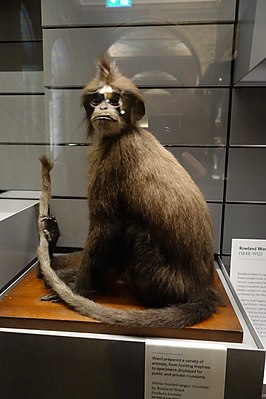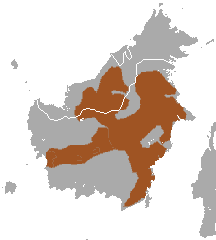White-fronted langur
| White-fronted langur | ||||||||||||
|---|---|---|---|---|---|---|---|---|---|---|---|---|

Museum preparation of the white-fronted langur |
||||||||||||
| Systematics | ||||||||||||
|
||||||||||||
| Scientific name | ||||||||||||
| Presbytis frontata | ||||||||||||
| ( S. Müller , 1838) |
The white- fronted langur ( Presbytis frontata ) is a species of primate from the group of the Schlankaffen (Presbytini).
features
The fur of the white-forehead langurs is gray-brown on the back and yellowish-brown on the belly, the hands and feet are black. The head is also black, which is characterized by the tuft of hair found in all cap langurs . The eponymous whitish patch is located on the front of the head of hair. With a weight of around 5.6 kilograms they are relatively small primates, they are slim built and have a long tail and long hind legs.
distribution and habitat
White-fronted langurs are only found on the island of Borneo . Its range includes the central and eastern parts of the island and extends from the Malaysian state of Sarawak to the Indonesian south coast. These animals live in deeper rainforests, they rarely occur at altitudes above 300 meters.
Way of life
White-fronted langurs are diurnal tree dwellers. They are skilled climbers who jump or move through the branches on all fours. They live in groups of 10 to 15 animals, these are mostly harem groups that consist of a male and several females and young animals. There are also males living solitary. These primates are herbivores who mainly eat young leaves, but also fruits and seeds. Like all slender monkeys, they have a multi-chambered stomach, which helps them utilize the hard-to-digest leaf food.
threat
Little is known about the endangerment level of the white-fronted langur. The ongoing destruction of the habitat is likely to be the main threat; the IUCN lists it under “too little data available”.
literature
- Thomas Geissmann : Comparative Primatology. Springer-Verlag, Berlin et al. 2003, ISBN 3-540-43645-6 .
Web links
- Presbytis frontata in the endangered Red List species the IUCN 2006. Posted by: A. Eudey & Members of the Primate Specialist Group, 2000. Accessed April 14 of 2008.
- Information on Theprimata.com
